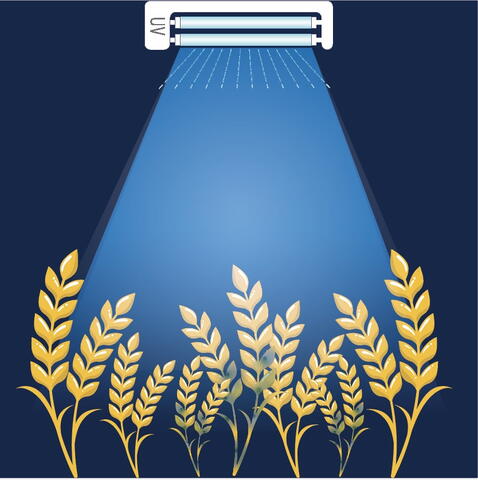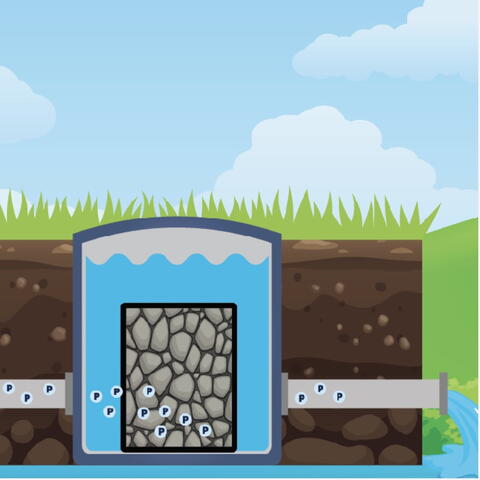
Our researchers improve food security, protect wildlife, ensure a clean water supply, develop climate change solutions, and bolster the health and sustainability of natural and managed systems. Public and private investments, legislator support, institutional partnerships, and the dedication of our faculty and students make this work possible.
Below, we showcase recent examples of our most impactful research in the area of agriculture and the environment. You can download a printable pdf version and also subscribe to one of our ACES e-newsletters to stay abreast of new developments in ACES research.
Discover Our Agriculture & Environment Research
Climate Smart Spuds Can Take the Heat

An Illinois research team has engineered potatoes to be more resilient to global warming, showing 30% increases in tuber mass under heatwave conditions. The advancement reduces photorespiration, which occurs when the key enzyme for photosynthesis (rubisco) mistakes oxygen for carbon dioxide. When this happens, plants create fewer of the carbohydrates needed for biomass production. Because photorespiration occurs more often when it's hot, heatwaves can stunt potato growth. When potatoes are engineered to make photorespiratory mistakes less often in hot conditions, photosynthesis operates optimally, creating more of the carbohydrates that plump up tubers. This adaptation may provide greater food security for families dependent on potatoes, especially in areas where climate change has already affected multiple crop seasons. The study was part of the Realizing Increased Photosynthetic Efficiency project, headquartered at U. of I. and led by ACES faculty.
Funding: The RIPE Project is funded by the Bill & Melinda Gates Foundation, Foundation for Food and Agriculture Research, and the U.K. Government's Department for International Development.
ACES researchers:
Katherine Meacham-Hensold, RIPE Project
Don Ort, Crop Sciences
Related news story:
Light Technology Mitigates Fungal Contamination of Cereal Grains

Fungal contamination of cereal grains poses a significant threat to food security and public health while causing hundreds of millions of dollars in economic losses annually. In a new study, ACES researchers tested the efficacy of far-ultraviolet C (far-UVC) light against two fungi, Aspergillus flavus and Fusarium graminearum. Both fungi affect grains in the field, leading to substantial losses in grain quality and producing mycotoxins that threaten human and animal health. First, the team blasted spores of both fungi with various doses of far-UVC, noting that 99.999% were inactivated at the highest dose. Next, they aimed the light at fungal mycelia and infected corn and wheat grains, both of which saw reductions in fungi up to 90%. Far-UVC emits light at 222 nanometers, a wavelength found to be safe for humans, even at prolonged exposure. If scaled up and commercialized, the technology could significantly boost food safety.
Funding: Funding was provided by ADMI and the USDA National Institute of Food and Agriculture.
ACES researchers:
Yi-Cheng Wang, Food Science and Human Nutrition
Zhenhui Jin, Food Science and Human Nutrition
Related news story:
Biochar Removes Phosphorus, Pharmaceuticals From Water

ACES researchers are demonstrating that designer biochar, a sustainable material made from sawdust and lime sludge, can remove harmful components from farm drainage water and drinking water. In one study, the research team compressed designer biochar into pellets of various sizes and placed them in chambers intercepting tile drains on a working farm in Illinois. Phosphorus stuck to the biochar as the water flowed through the chambers, removing up to 41% of the polluting nutrient from downstream waterways. In a second lab-based study simulating drinking water plants, the researchers combined biochar pellets with woodchip bioreactors — a system they call B2 — demonstrating significant reductions in pharmaceutical products, nitrogen, and phosphorus. In both studies, the team conducted further analyses to project cost and efficacy if biochar solutions were implemented at scale, finding the material is both effective and inexpensive.
Funding: Funding for these studies was provided by the U.S. Environmental Protection Agency, the USDA National Institute of Food and Agriculture, and the Illinois Nutrient Research and Education Council.
ACES researchers:
Hongxu Zhou, Agricultural and Biological Engineering & Illinois Sustainable Technology Center
Wei Zheng, Agricultural and Biological Engineering & Illinois Sustainable Technology Center
Rabin Bhattarai, Agricultural and Biological Engineering
Related news stories:
Study combines woodchips and biochar to clean water of pharmaceuticals, nutrients
Scientists tackle farm nutrient pollution with sustainable, affordable designer biochar pellets
Invasive Fish Stopped by Chicago-Area Water Pollution

Invasive silver carp have been spreading throughout the Mississippi River Basin since their introduction a half-century ago. Yet, try as they might, the fish have not advanced beyond a particular stretch of the Illinois River north of Kankakee. ACES research shows the fish are likely avoiding contaminants from the Chicago Area Waterway, which flows south before petering out around Kankakee. The study shows silver carp slow their movement and show signs of physiological stress when introduced to water from that area. In previous work, the researchers showed carp near Kankakee were turning on genes related to toxin removal and turning off genes responsible for DNA repair and protective measures in their livers. While neither study pinpoints the exact contaminants responsible, it's clear that something in the water is deterring carp invasion. However, with cleanup efforts underway in Chicago, the barrier may not hold for much longer.
ACES researcher:
Cory Suski, Natural Resources and Environmental Sciences
Related news stories:
Study: Invasive silver carp reduce movement in Chicago-area water
Chicago water pollution may be keeping invasive silver carp out of Great Lakes, study says